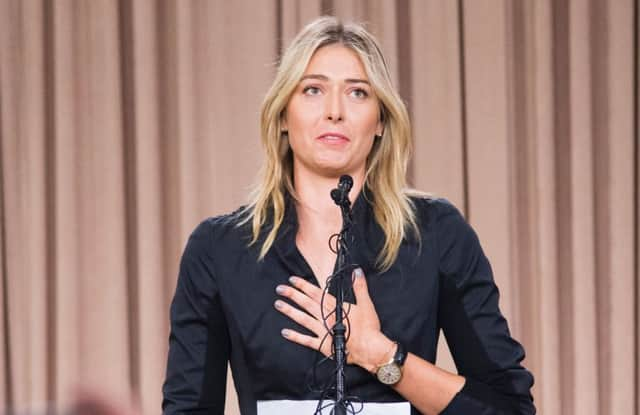Andy Murray: Sharapova case can be good in the long run


The Scot has always been clear in his views on doping – cheats must be caught and punished.
Even though Maria Sharapova is the most famous female tennis player on the planet, she has admitted that she had made a mistake – she tested positive for the heart drug Meldonium in January and owned up to the fact on Monday – so Murray believes she should face a ban like any other drug cheat.
Advertisement
Hide AdAdvertisement
Hide AdBut the very fact that Sharapova has spoken publicly about the matter is a rarity in tennis.
Since the sport started testing for performance enhancing drugs at the start of the 1990s, there have been 38 known cases. Most of those were discovered through the anti-doping process but a few – such as Andre Agassi and John McEnroe – were revealed when the player had long since retired and confessed to indiscretions in their tell-all autobiographies.
Some of the players, such as Greg Rusedski, were exonerated. He was cleared of all charges in 2004 when the ATP, the organisers of the men’s tour, admitted that their own trainers may have been handing out supplement tablets contaminated with nandrolone. But, of those 38 names on the list, fewer than 10 are players the average sports viewer would ever have heard of.
“In the past, a lot of times people have said that it is the lesser names that have come out,” Murray said, “even though there has actually been more big names than you would think, but Maria is probably the biggest female athlete in the world maybe, the most recognisable. That’s why I said it was like a positive that it’s actually out there. I think if nothing was said about it, that’s when it’s actually really, really bad for the sport even though some people may say ‘OK, it’s good’. It’s not.”
Murray wore a wry smile as he said this. Speaking at the start of the BNP Paribas Open, he was surrounded by representatives from the ATP, the tournament and from his own management company.
The word “drugs” is blasphemy in such company and, in the past, the sport has done its best to hide players who were identified by the anti-doping process but then exonerated. If the anti-doping tribunal says the player is innocent, then the failed drug test never happened – or that seems to be the reasoning. As Murray spoke, there was an uneasy shifting from foot to foot by those officials listening.
Rusedski’s case is only public knowledge because he outed himself. As he was going through the laborious tribunal process, it was known that six other players had also tested positive for nandrolone. They, too, were exonerated, but their identities were kept secret.
Now that Sharapova has gone public, tennis has to face up to one of its biggest stars facing a ban that could end her career. This is new territory for the sport.
Advertisement
Hide AdAdvertisement
Hide Ad“It’s never easy when something like that is happening in your sport but you have to sort of try to accept it in a way,” Murray said. “It happens in all sports. Tennis is no different to other sports – I think some people seem to think it is but it’s not – and you just wish it didn’t happen but it does. So you have to accept it.”
What Murray is also willing to accept is that Sharapova’s case may not be the last in tennis. Meldonium was only added to the World Andi Doping Agency’s proscribed list at the beginning of this year but its widespread use had been known to WADA for some time. Sharapova is the first tennis player to have tested positive for the substance – or the first player that anyone knows about so far – but many other athletes have been found to have been taking it since 1 January.
“It’s possible [that other tennis players have taken it] but I don’t know,” Murray said. “I don’t know if we’ll ever find that out but it’s possible, for sure. I saw some stats from the European Championships in Baku and it was like 66 athletes taking it across a number of different sports there so it is possible.”